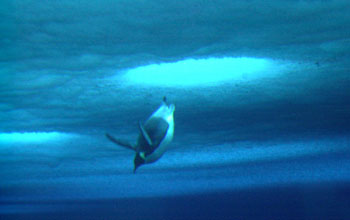Multimedia Gallery
Penguin Diving Study (Image 2)
An emperor penguin dives through a hole in the sea ice into the water below McMurdo Sound. Paul Ponganis from Scripps Institution of Oceanography and his team study emperor penguins' diving. The routine occurrence of 500 meter dives during foraging trips is a physiological and behavioral enigma. Ponganis examines pressure tolerance, management of oxygen stores, end-organ tolerance of diving hypoxemia/ischemia and deep-dive foraging behavior. This information provides insight into human diving physiology and has medical applications for patients whose organs or tissues have been deprived of oxygen due to heart attack, stroke, transplant, etc. To learn more about Ponganis' research, visit http://antarctic.ucsd.edu. [See related image Here.] (Date of Image: Nov. 3, 2004)
Credit: Photo by Emily Stone, National Science Foundation
Images and other media in the National Science Foundation Multimedia Gallery are available for use in print and electronic material by NSF employees, members of the media, university staff, teachers and the general public. All media in the gallery are intended for personal, educational and nonprofit/non-commercial use only.
Images credited to the National Science Foundation, a federal agency, are in the public domain. The images were created by employees of the United States Government as part of their official duties or prepared by contractors as "works for hire" for NSF. You may freely use NSF-credited images and, at your discretion, credit NSF with a "Courtesy: National Science Foundation" notation.
Additional information about general usage can be found in Conditions.
Also Available:
Download the high-resolution JPG version of the image. (2.3 MB)
Use your mouse to right-click (Mac users may need to Ctrl-click) the link above and choose the option that will save the file or target to your computer.



